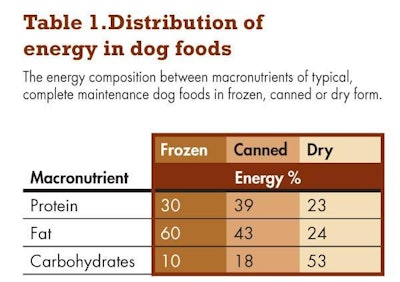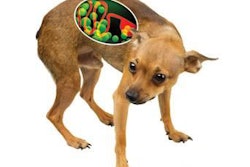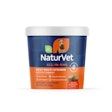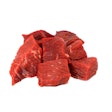
Ingredient mixtures of industrially produced, complete canine foods can vary markedly, but still be equally good. Feeding of dogs should aim at supplying adequate amounts of nutrients in an available, palatable and safe form that supports a healthy and long life. This rational approach, combined with practical experience, allows dogs to be fed on a wide variety of formulas. Clearly, the complete foods for dogs of various ages and physiological states must accommodate the nutrient requirements.
Dog food must contain fats to meet the requirement of essential fatty acids, but the fat level is flexible. Most foods contain carbohydrates, mainly as starch, but carbohydrates are not indispensable. The fiber fraction also contains carbohydrates. Fiber is not a required nutrient and its energetic contribution is neglected. Here, the term carbohydrates excludes fiber. With regard to digestion and metabolism, dogs can handle a wide range of dietary amounts of fat and carbohydrates. This makes it possible to produce different, but adequate foods, provided that the recommended allowances of amino acids (protein), minerals, trace elements and vitamins are met.
The distribution of total food energy over proteins, fats and carbohydrates can be calculated from their contents in the food concerned and their accepted energy values. Table 1 illustrates the energy composition of typical, complete maintenance dog foods in frozen, canned or dry form. When fed dry food as a sole source of nutrition, a dog obtains most calories from the carbohydrate component. Frozen food contains fat as a major energy source. Proteins and fats provide similar amounts of calories for canned food.
Although the three foods are very different, they all can be considered appropriate nutrition for healthy dogs. Possibly, dogs fed canned food need more dental care to control periodontal disease.
New dog food trends flourish through rejection of settled foods. Within the current natural trend, grain-free and low-carbohydrate foods are promoted. Grain-free foods are either low in carbohydrates or contain other starch-rich ingredients such as potato or cassava roots. Justification of grain-free foods follows from objections toward grains and carbohydrates. However, these objections are not backed by scientific evidence. On the contrary, the available evidence indicates that dogs thrive on grain-containing, carbohydrate-rich, dry foods.
Commonly used arguments against cereal grains and starch are:
- Dogs are carnivores not designed to consume and utilize grains not being part of the natural canine diet.
- Dogs cannot digest starch.
- Grains are used as filler.
The notion of carnivore is not relevant for domesticated dogs fed by their keepers. As mentioned, proper feeding of dogs is supplying adequate amounts of nutrients in an available, palatable and safe form. Grinding and cooking of grains destroys their structure and exposes the starch constituent for optimum utilization by dogs that are well equipped to digest high amounts of starch. Grains provide carbohydrates and protein and, when fit into balanced formulas, serve nutritional purposes.
It is sometimes said that grain-containing, high-carbohydrate diets cause diseases such as food allergy, obesity, diabetes, osteoarthritis and cancer. Grains do not impose an extra risk of canine food allergy. Wheat induces adverse food reactions as commonly as does beef. Corn and rice rarely cause food allergy. Higher intake than expenditure of food energy causes obesity, irrespective of the composition and form of the diet. The development of diabetes and osteoarthritis in dogs is associated with obesity rather than diet type and this may also hold for cancer.
Dogs have no nutritional need for carbohydrates. A carbohydrate-free diet provides energy as protein and fat. Dietary carbohydrates contribute to blood glucose, which is essential for brain function. In a carbohydrate-free diet, protein is the only precursor for blood glucose so its level must be higher than the recommended allowance. In practice, low-carbohydrate dry foods are high in protein, serving as carbohydrate replacer. Three kinds of dog foods can be distinguished: high-carbohydrate/normal-protein, low-carbohydrate/high-protein and carbohydrate-free/very-high-protein diets. When formulated properly, they all provide adequate nutrition for healthy dogs.
For the time being, it can be assumed that the current recommended nutrient allowances endorse the production of healthy dog foods within the degrees of freedom. At present, there are no indications that one food variant is unequivocally superior over another when fed to healthy dogs. Results of future research will probably demand reconsideration.
















